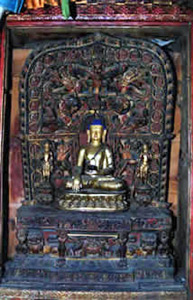

Chenga Sherab Jungne (1187-1241) bestowed the king of Purang, Jowo Atigman (jo bo a tig sman), with spiritual teachings and the transmission of Mahamudra. In turn, as a token of appreciation, the king presented the Drikung order with additional territories and with the famous shrine of Khojar (kho char lha khang), known as the shrine of Khojarnath. Up to the present day the impressive building, surrounded by whitewashed stupas and a large wall of mani-stones and yak-skulls inscribed with mantras, is one of the foremost objects of pilgrimage in western Tibet. During the period in which Drikung took control of Khojarnath, in 13th and 14th century, the Drikungpa found also patronage in the Buddhist rulers of the Khas Malla kingdom in Western Nepal.
When Denma Kunga Drakpa (ldan ma kun dga’ grags pa) was living in the region during the 16th century, he became not only the root master of the king of Guge, Jigten Wangchug Pekarde (‘jig rten dbang phyug pad dkar lde), but also of the district commissioner of Purang, Sonam Rabten (bsod nams rab brtan). They both restituted to the Drikungpa a number of estates that had been lost.
The most important Drikung monastery in Purang is Gongphur Gompa. Gongphur Monastery is situated on the slope of the mountain Tegla Kar, just outside Purang County. The monastery consists of six cave-temples including the Dukhang (assembly hall), Kangyur Lhakhang (the Sutra Temple), Gonkhang (Dharma Protectors’ Room), and Palde Lhakhang (a small shrine room). Two caves are used for retreat, and there are caves where the monks live.
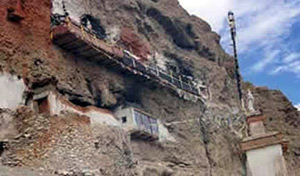
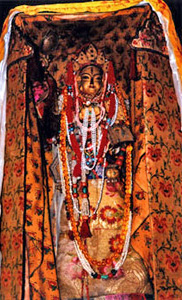
The monastery was offered by the king of Purang to Senge Yeshi, a close disciple of Kyobpa Jigten Sumgon, in the 13th century. Since then it has been a monastery of the Drikung Kagyu tradition. Up to the present day, a continuous lineage of reincarnations of Druptop Senge Yeshi (Limi Tulku) has served as the head of Gongphur Monastery. In 1994, the current Reincarnation of Senge Yeshi, Senge Tenzin Rinpoche, was recognized and enthroned by His Holiness the Drikung Kyabgon Chetsang at Jangchubling Monastery in Dehra Dun, India.
Gongphur is among the few monasteries in Tibet still keeping precious sacred objects, which could be saved during the Cultural Revolution. The main object of devotion of the monastery is a standing Achi Chokyi Dolma statue in the assembly hall. It is said that among the relics inside the statue is a finger of Kyobpa Jigten Sumgon. Another very precious statue of the monastery is one of Kyobpa Jigten Sumgon himself. It is one of the famous statues with “tooth imprint”. There are two versions of the story, how these statues came into being. During Kyobpa Jigten Sumgon’s lifetime a thousand statues in his likeness (sku ‘dra) were made.
Some say that Jigten Sumgon was asked to bless them, and in doing so, bit one of the statues on the head. Others report, that he imprinted his tooth on one of the statues in order to testify, that the statue truly resembles him. Miraculously the same tooth imprint appeared on all the other statues as well. Later these statues were distributed among the Drikung Kagyu monasteries. Some of them are still kept in various places and are highly revered. In Gongphur there is also a hand print of the previous Chetsang Rinpoche, Shiwe Lodro (1886-1943).
The monasteries in the remote Limi area used to be strongly connected with Gongphur Gompa. Nowadays however they are separated by the border, as Lime is situated just across the border in Nepal. When Gongphur was reopened in 1985 just one monk survived from the times prior to the Chinese occupation, who could perform the rites and rituals for the needs of villagers, and teach novice monks. There were about a dozen monks living at the monastery recently, but as the government only allows five monks to live in the monastery, some of them escaped to India to pursue higher education in the major monasteries like the Drikung Kagyu Institute and others.
The exquisitely beautiful valley of Limi in the Humla region of Nepal, bordering with Tibet close to Purang and the Mount Kailash area, is very remote and even today not accessible by driving. Therefore Tibetan culture and the Drikung tradition could survive there unbroken up to the present. A river winds its scenic way through the valley with the three villages of Zang, Weltse and Til and their monasteries Zang Phelgye Ling, Weltse Rinchen Ling and Til Kunzom Dho Ngag Ling. Limi’s isolation was the reason why a multitude of ancient, rare and very precious religious objects could be preserved in these monasteries. Moreover, during the great exodus from Tibet in 1959, the prudent people of the area acquired many artifacts from émigrés in Kathmandu for their temples and monasteries, which now house superb collections. The most precious thangkas and statues remain under lock and key, guarded by the most trustworthy members of the community.
Weltse Rinchen Ling is the central monastery of the three monasteries of Limi. It is also the headquarters of the Limi Tulku (currently Senge Tenzin Rinpoche).
Weltse Rinchen Ling Monastery was established in the early 10th century by the famous translator Rinchen Sangpo (958–1055).
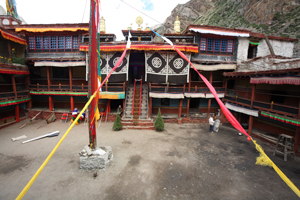
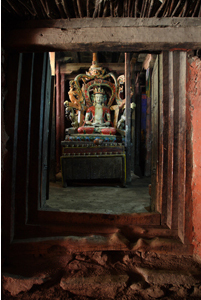
It used to follow first the Kadampa tradition and later that of the Sakyapa.
In the 15th century the monastery was turned over to the Drikung Kagyu Order by a ruling of the king, because a sectarian clergyman of the Sakyapa Order had killed a Drikung Kagyu monk.
Among the principal objects in the monastery is a four meters high golden image of Maitreya dating from the time of the foundation of the building.
Apart many other valuable effigies and thangkas the monastery houses a three hundred years old and three storeys high appliqué thangka of Kyobpa Jigten Sumgon.
In the early 13th century Chenga Sherab Jungne (1187-1241), one of the main disciples of Jigten Sumgon, founded Tilchen monastery on the hilltop of Zang village, near his meditation cave (Gompug) on the side of a rocky mountain. As the local populace was unable to pay the heavy taxes imposed on them during the 15th century by the legendary five brothers of the Kingdom of Zumling, they were forced to shut down the monastery.
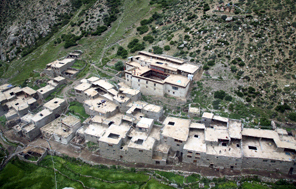
They transferred the religious items and valuable possessions to Weltse Monastery. About 400 years ago the local people decided to reconstruct the monastery and named it Zang Phelgye Ling. All the sacred objects were brought back.
Today the monastery keeps many important ancient objects, including a set of unusual masks for the monastic Vajra Dances, as well as contemporary works, like three giant thangkas for the assembly hall of the monastery. The roof of the hall had to be raised because of the size of the images.
This monastery was built on the spot where Lama Kunzom practiced solitary retreat in the 12th century. The hill where the monastery is situated is like a white snake heading up and a black snake heading down. The building is located exactly on the ear of the black snake. Lama Kunzom offered the monastery to Druptop Senge Yeshi.
The monastery has many special religious objects, including some outstanding wall paintings, especially in the cave where Lama Kunzom practiced. But the most important religious object in this monastery is a so-called “speaking statue” (gsung byon ma) of Buddha Shakyamuni.
It is reported that this image, whenever an epidemic spreads through Limi, takes on the sickness itself. Black spots appear on the face of the image and when the disease goes away, the image recovers its normal appearance.
Traditionally, such cases are kept secret by the monks and they cover the image in a clean cloth.
